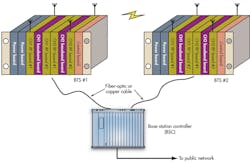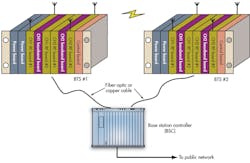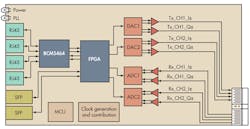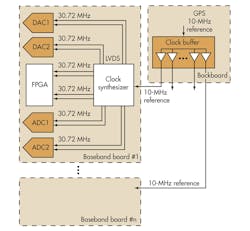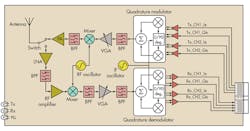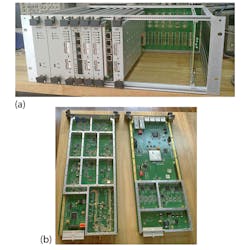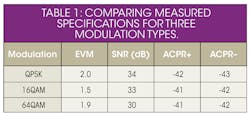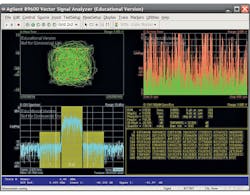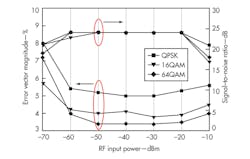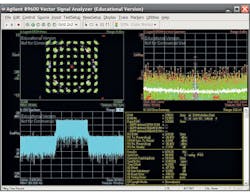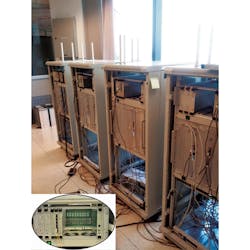MIMO Transceivers Aid TD-LTE Systems
This file type includes high resolution graphics and schematics when applicable.
Mobile data traffic is growing quickly, and Long-Term-Evolution (LTE) cellular communications technology offers a low-cost means of satisfying this growing appetite for wireless data. LTE systems provide spectrum flexibility, allowing bandwidth to be selected between 1.4 and 20.0 MHz depending upon available spectrum, to meet the needs of network operators with different bandwidth allocations. One of the two variants of LTE, time-division LTE (TD-LTE) technology, has become a standard fourth-generation (4G) mobile telecommunications technology for China. Co-developers include China Mobile, Alcatel-Lucent Shanghai Bell, ZTE, ST-Ericsson, and Qualcomm. Improved performance in these TD-LTE systems is possible by using compact multiple-input and multiple-output (MIMO) transceivers.1,2
Related Articles
• Signal Generator Simplifies Complex MIMO Tests
• MIMO/Diversity Antenna Serves Multiple Applications
• Q-Band Transceiver Makes MIMO Links
The compact MIMO transceiver design presented in this article includes the analog baseband processor and RF transceiver. It can support MIMO configurations as large as 8 x 8 flexibly for high-speed capacity. Data transmission between the subsystem and the digital baseband unit of the base station can be implemented by either the fiber-optic or local-area-network (LAN) cable. The MIMO subsystem occupies eight channels from 3.411 to 3.551 GHz in 20-MHz steps, which can be configured dynamically. The subsystem has been used successfully in a TD-LTE trial network established by Alcatel Shanghai Bell Co. Ltd.
The TD-LTE base-station MIMO transceiver subsystem supports two types of interface. The optical Common Public Radio Interface (CPR™) is suitable for long-distance data-link applications such as the Radio Remote Unit (RRU), while the Gigabit Ethernet (GE) interface can support short-distance data-link applications such as microcells and picocells. The MIMO transceiver subsystem allows multiple baseband and RF circuit boards to be integrated into a miniature 4U high subrack. The transceiver subsystem works in 20-MHz channels, from 3.411 to 3.551 GHz. Excellent performance is possible with different modulation types and a 20-MHz TD-LTE signal.
Figure 1 shows the overall configuration of a TD-LTE base station. The function of the transceiver subsystem is to transfer digital signals by means of optical fiber or LAN cable links using the base station controller (BSC). As an alternative approach to the configuration presented in ref. 3, a 2 x 2 MIMO unit can provide improved performance using one baseband circuit board and two adjacent RF transceiver circuit boards. This configuration enables the design of a transceiver subsystem that is compact and flexible. To better understand this transceiver design, it will be examined more closely in terms of its baseband processing unit and its RF transceivers.
As a block diagram of the baseband processing unit shows (Fig. 2), it can be divided into several parts. These include the field-programmable-gate-array (FPGA) processor; the optical-fiber interface circuit; the clock management circuit; and the data-converter circuits with analog-to-digital converters (ADCs) and digital-to-analog converters (DACs). The FPGA is the core of the baseband circuit board, responsible for data transmission with base-station controllers by LAN cable or optical fiber and timing logic control with ADC and DACs. A Virtex-5 XC5VSX95T FPGA from Xilinx is used in the baseband processing unit in part for its logic resources and processing capabilities, and also because of its low cost. The on-board FPGA can also be used for some signal processing, such as calibration and digital predistortion (DPD),4,5 to make the baseband unit even more flexible.
This transceiver subsystem incorporates multiple synchronized clocks in addition to data converters, so the clock management scheme is necessarily complex. Compared to other clocks in the system, the converter sample clock must have very low jitter because of the effect of jitter on converter signal-to-noise ratio (SNR). Figure 3 shows the transceiver subsystem’s system clock distribution diagram.
Clock Complexity
The channel bandwidth of a TD-LTE system is 20 MHz. The corresponding sample clock for DACs and ADCs in the system is 30.72 MHz, according to the specification of the LTE physical layer.6 The sample clock is supplemented by a clock synthesizer which integrates a phase-lock-loop (PLL) circuit and the clock-distribution circuit. The PLL function of the clock synthesizer generates a low-jitter 30.72-MHz clock signal from the reference clock, while the clock-distribution circuit provides a multiple output to the converters in the baseband circuit board. All reference signals on the baseband boards, as well as RF transceiver boards, are buffered from a Global-Positioning-System (GPS) clock by a clock buffer chip on the back board.
This file type includes high resolution graphics and schematics when applicable.
In a DAC-based system, digital interpolation can be used to relax the requirements on the output anti-image filter. The interpolation process does not increase the amount of information contained in the original input data stream; instead, it adds extra data points, increases the output data rate, and makes it easier to filter the images. The on-board AD9779A DAC from Analog Devices contains an integral interpolator which doubles, quadruples, or octuples the input data rate by stuffing zeros between successive samples and then filtering the result.
Figure 4 offers a comparison of a 10-MHz sinewave signal with interpolation factor set to 8 and the same signal without interpolation. For a DAC without interpolation, images are located at:
NFDAC ± Fout
and follow a sin(x)/x envelope [Fig. 4(a)]. With an 8x interpolator, these images were effectively suppressed at lower frequencies [Fig. 4(b)]. To remove undesired images and spurious signals far from the carrier after interpolation, only a very simple post-DAC analog filter is needed.
A superheterodyne topology similar to that presented in ref. 7 was adopted for the best performance. The transceiver can support eight frequency channels in 20-MHz steps from 3.411 to 3.551 GHz. Different frequency bands can be set by configuring the PLL on the circuit board in accordance with the decoded commands sent from the main processor. Figure 5 shows the architecture of the RF transceiver while ref. 8 offers design consideration and more detailed measurement results for some key figures of merit, including output power, linearity, error vector magnitude (EVM), and third-order intermodulation distortion (IMD3).
Differential I/Q analog signals between RF transceiver and baseband board are interconnected through the high-speed connectors installed in a backboard. Besides I/Q signals, the interface also links the transmitting power control signal, the receiving gain control signal, the transceiver switch signal as well as the configuration signal forfrequency synthesizers.
Figure 6(a) shows the designed subsystem, in a configuration which offers some flexibility in terms of the number of channels. The first two boards from the left are power-supply boards providing DC-DC conversion from -48 to +6 VDC and -48 to +3.3 VDC to produce the voltages required by the baseband boards and RF circuit boards, respectively. The first circuit board from the right is the controller board, which handles all control signals to the RF and baseband interface. The middle section is for baseband and RF boards. One baseband circuit board, together with two RF circuit boards distributed on both sides, consists of a 2x2 MIMO unit. With the top configuration,the subsystem consists of four 2x2 MIMO units, which supports an 8x8 MIMO channel. Figure 6(b) shows the separate baseband and RF circuit boards.
In this MIMO system, EVM, a modulation quality metric widely used in digital communication systems, is thoroughly optimized to achieve excellent performance. Using the 89600 vector signal analyzer (VSA) software from Agilent Technologies, impairments to EVM such as magnitude error, phase error, frequency error, and in-phase/quadrature (I/Q) offset can be analyzed to troubleshoot potential problems in the design.
In the first test case, various transmitter specifications, such as EVM, signal-to-noise ratio (SNR), and adjacent channel power ratio (ACPR) were measured. For testing, complex baseband I/Q signals with QPSK, 16QAM, and 64QAM modulation types was created in MATLAB® software from MathWorks. The signals were downloaded to the FPGA on the baseband board and then fed to the RF board for modulation and upconversion to generate the required higher frequencies. The baseband I/Q data symbol rate was 15.36 MSamples/s, with a bandwidth of 19.2 MHz that considers the root-raised cosine filter having an alpha value of 0.25. The average output power of the power amplifier on the RF board was +23.1 dBm. For this testing, measurement results are listed in Table 1, with a VSA-produced constellation diagram shown in Fig. 7.
In the second test case, the receiver’s EVM and SNR were measured with QPSK, 16QAM, and 64QAM modulation. The parameters of the reference signal were same as in the first case. Complex baseband signals were modulated to 3.415 GHz internally within a model E4438C vector signal generator (VSG) from Agilent Technologies. Figure 8 shows the measured results, with an input dynamic range of -70 to -10 dBm.
Summing Up
Finally, customized TD-LTE waveforms were created via Signal Studio software from Agilent Technologies. To characterize the performance of the subsystem for LTE applications, these waveforms were compliant with 3GPP LTE TDD specifications. The transmission bandwidth was set to 20 MHz, with data channel modulation types of QPSK, 16QAM, and 64QAM. Similar to the approach used in the first test case, waveforms were downloaded to the FPGA for continuous play.
Related Articles
• Signal Generator Simplifies Complex MIMO Tests
• MIMO/Diversity Antenna Serves Multiple Applications
• Q-Band Transceiver Makes MIMO Links
Figure 9 shows the measurement results with the VSA for a TD-LTE signal with 64QAM modulation. Table 2 shows the measured EVM performance levels for the other two modulation types, with 3GPP specified as a comparison.9 The maximum EVM of three modulation types was only 2.8% RMS, far exceeding the 3GPP requirements. Figure 10 shows a TD-LTE trial network using the MIMO subsystem and a BSC platform designed by Alcatel-Lucent Shanghai Bell, with the two subsystems communications by means of LAN cable; the left-hand corner of Fig. 10 shows a trial network communicating through optical fiber.
In short, the subsystem is suitable for TD-LTE base stations, making effective use of flexible and compact MIMO transceivers. As the measurement results show, it provides performance levels that more than meet the needs of modern TD-LTE systems.
Acknowledgements
This work was supported in part by the National Natural Science Foundation of China under Grant No. 60702163, and in part by the National Science and Technology Major Project of China under Grant 2010ZX03007-002-01, and 2011ZX03004-003. The authors would also like to acknowledge the assistance and support of Alcatel-Lucent Shanghai Bell Co. Ltd.
Lianqing Ji, Ph.D. Candidate
Jianyi Zhou, Professor
Ke Zhou, Ph.D. Candidate
Jianfeng Zhai, Vice-Professor
State Key Laboratory of Millimeter Waves, School of Information Science and Engineering, Southeast University, Nanjing, Jiangsu, 211111, People's Republic of China.
References
1. I.E. Telatar, “Capacity of multi-antenna Gaussian channels,” European Transactions on Telecommunications, Vol. 10, No. 6, 1999, pp. 585-595.
2. G.J. Foschini and M.J. Gans, “On limits of wireless communications in a fading environment when using multiple antennas,” Wireless Personal Communications, Vol. 6, No. 3, March 1998, pp. 311-335.
3. L. Ji, J. Zhao, and J. Zhou, “Design of a compact hardware platform for broadband MIMO channel measurement,” in 2011 Asia-Pacific Microwave Conference (APMC) Proceedings, pp. 1422-1425.
4. J. Zhao, J. Zhou, J. Zhai, X. Liang, and W. Hong, “An Automatic Error Compensation Method For The Feedback Loop In Adaptive DPD Systems,” Microwave Journal, Vol. 51, No. 8, August 2008, pp. 64-83.
5. J. Zhao, J. Zhou, X. Liang, and J. Zhai, “Error Compensation for Digital Predistortion Linearizers,” Microwave Journal, Vol. 50, No. 10, October 2007, pp. 16.
6. 3GPP, TR 25.814 Ver. 7.1.0, “Physical Layer Aspects for Evolved UTRA (Release 7),” September 2006.
7. Z. Yu, J. Zhou, J. Zhao, T. Zhao, and W. Hong, “Design of a Broadband MIMO RF Transmitter for Next-generation Wireless Communication Systems,” Microwave Journal, Vol. 53, No. 11, November 2010, pp. 22-26.
8. K. Zhou, J. Zhou, and Z. Xu, “Design of a high performance RF transceiver for TDD-LTE system,” 2012 International Microwave Theory & Techniques Symposium (MTT-S) digest, pp. 1-3.
9. 3GPP TS 36.101-v9.4.0, “E-UTRA user equipment radio transmission and reception. Evolved UTRA (Release 7),” June 2010.
This file type includes high resolution graphics and schematics when applicable.
